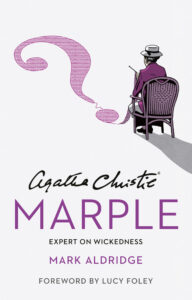It should be no surprise to anyone that Agatha Christie’s Miss Marple has always been a reassuring presence. After all, her first appearance followed an exciting but also tumultuous time for Christie. The beginning of the 1920s saw the publication of her debut novel, The Mysterious Affair at Styles – the first of many adventures for the Belgian detective Hercule Poirot. Christie then went on to write short stories and thrillers alongside her mystery novels, while her day-to-day life was enhanced by a ‘Grand Tour’ in 1922, which saw her travelling the world alongside her husband, Archie. However, by the time that Miss Marple made her debut in December 1927, Christie’s life had been turned upside down. In 1926, she had a breakdown following the death of her mother and Archie’s decision to leave her for another woman. Both this breakdown and the subsequent well-publicised disappearance took some time to recover from, and yet these difficult events also coincided with the publication of The Murder of Roger Ackroyd, a novel that has since taken pride of place as one of Christie’s masterpieces.
Agatha Christie’s career was flourishing just as her life seemed to be falling apart. So it is notable that it was shortly after these events that she created a new character, whose entire raison d’être was to be a calm point in a stormy sea. Miss Jane Marple is an unmarried older lady who has spent most of her life in the small village of St Mary Mead, and her quiet observations of people and relationships give her great insight into character. For Miss Marple, these observations serve to prove that, whatever else is happening, human nature remains fundamentally the same. Miss Marple herself rarely seeks the spotlight, and, in the earlier short stories, almost functions as a punchline to a joke being played on other characters as the thoughtful old lady in the corner outwits her more forthright acquaintances. In doing this, Miss Marple shows that things will be all right in the end. Whatever the drama, the truth prevails, which was and is a reassuring fact for both readers and, we can presume, for Agatha Christie herself. Nevertheless, Miss Marple is not simply some kind grandmotherly figure. She has a steely streak, and an unerring ability to frustrate almost as many people as she charms, while her quest for the truth knows few barriers. In Nemesis, the final Marple story to be written, she finally concedes that ‘you know, I could be ruthless . . .’ By this point, Miss Marple has gained a reputation as a person who can detect and remedy the ‘wickedness’ that she sees in everyday life. She is happy to do this, suggesting that ‘I hope you dear young people will never realise how very wicked the world is.’
This book charts the progress of Miss Marple from her short-story origins to later ventures on stage, screen and beyond, which now includes new mysteries written by some of the best crime writers working today – a true tes- tament to the staying power of Agatha Christie’s creation. Miss Marple’s appearances in other media have resulted in some more radical versions of the character, from Margaret Rutherford’s comical sleuthing in the films of the 1960s to the quirky Geraldine McEwan portrayal of the twenty-first century, in which she mourned a lost love. Each interpretation has its own fans and, as we shall see, even Christie’s original Miss Marple stories show subtle changes to the character as society develops. Contradictory evidence doesn’t allow us to pinpoint precisely when Miss Marple was born; she is both an elderly lady of the Victorian era in 1927 as well as an elderly lady of the World Wars generation in the 1970s. For Christie, ‘Miss Marple was born at the age of sixty-five to seventy’, but nevertheless she lives on to witness the rise of modern society, which she views with fascination. Miss Marple may be nostalgic for a lost past, but she isn’t a reactionary.
For fellow mystery writer Christianna Brand, Miss Marple was surely created to be the antithesis to Hercule Poirot, who Brand considered to be ‘all shine and show-off’. Brand described Miss Marple as ‘the very pink of modest self-deprecation’, with her ‘quiet confidence in her own powers’, which is ‘robustly bolstered up, should it ever fail her, by the adulation of her somewhat unremarkable friends.’ These ‘unremarkable’ associates include her novelist nephew Raymond West, while other important figures in Miss Marple’s life drift in and out as stories demand it. Many of them are residents of St Mary Mead, from the local servants to the well-heeled Arthur and Dolly Bantry of nearby Gossington Hall.
It may be easy to think of Miss Marple as a character who had much in common with Agatha Christie, but it’s wrong to do so. For one thing, Christie was only in her thirties when she created the character, and she later complained that ‘I never can see why anybody thinks that I resemble Miss Marple in any way’, before acknowledging that she may be more like Ariadne Oliver, the fictional mystery writer who appears in several of Christie’s novels. As Christie told a fan, Miss Marple tended her garden and ‘lived all her life in the country, which is why her nephew considered (quite falsely) that she knew nothing about life. I have spent a great part of my life travelling in all sorts of interesting and exciting places, and, nomadic by temperament, my hobby has been travelling and music, and a love of gardens, but not much practical gardening.’
Although Christie rejected the idea that she was a feminist, strong female protagonists were an important feature of many of her novels, and the intelligence and determination shown by Miss Marple is just one example of this. Some of the other examples are obvious, including the likes of Prudence Cowley (better known as Tuppence Beresford), whom we first meet in 1922’s The Secret Adversary, and is shown to be more than a match for her eventual husband Tommy when it comes to solving mysteries through adventurous escapades. But in Christie’s work a ‘strong woman’ can mean many things, from professional nurse Amy Leatheran (who narrates Murder in Mesopotamia) to the icy manipulation of Romaine Vole in Witness for the Prosecution, a woman who will do anything to prove her husband is innocent of murder. The strength of Miss Marple may not always be obvious, because she plays her cards close to her chest, but her determination always shines through by the end of each mystery. This determination is important both in terms of proving that her conclusions are correct, and her unerring belief that justice must be done.
In terms of Miss Marple’s origins, Christie often cited relatives and family friends as influences, which is unsurprising given her strongly matriarchal family background. ‘There is no particular model for Miss Marple,’ she confessed; ‘some of her remarks and points of view are reminiscent of my own two grandmothers, and of their friends and acquaintances, whom I knew in my youth.’ There exists a letter that appears to show that Christie thought that the name must have been inspired by the ‘beautiful old manor’ Marple Hall, near to Abney Hall (now in Greater Manchester), which was where her sister lived. Readers are given relatively little background to the character herself, and instead learn much more from the way that she reacts to other people and events. In 1970 Christie wrote to a scholar who had penned his own biography of Miss Marple and confessed that ‘If you know “the career of Miss Marple” from childhood upwards, you know more than I do! Indeed, I have never thought very much about her childhood.’ In terms of Miss Marple’s character, a recent creation was an important influence: ‘I think it is possible that Miss Marple arose from the pleasure I had taken in portraying Dr Sheppard’s sister [Caroline] in The Murder of Roger Ackroyd,’ Christie wrote in her autobiography. ‘She had been my favourite character in the book – an acidulated spinster, full of curiosity, knowing everything, hearing everything: the complete detective service in the home.’ It was when the story was adapted for the stage by another writer that Christie realised the potential for a reworked version of the character, as the play changed Caroline into a younger love interest, renamed Caryl. ‘I resented the removal of Caroline a good deal,’ she later complained. ‘I liked the part she played in village life: and I liked the idea of village life reflected through the life of the doctor and his masterful sister.’ This turn of events was to have greater significance for Christie: ‘I think at that moment, in St Mary Mead, though I did not yet know it, Miss Marple was born and with her Miss Hartnell, Miss Wetherby, and Colonel and Mrs Bantry – they were all there lined up below the border-line of consciousness, ready to come to life and step out on to the stage.’
Miss Marple – the underestimated but ruthless sleuth of St Mary Mead – had arrived.
___________________________________
Published by HarperCollinsPublishers 2024
Copyright © Mark Aldridge 2024
AGATHA CHRISTIE, MARPLE, the Agatha Christie Signature
and the AC Monogram Logo are registered trademarks of
Agatha Christie Limited in the UK and elsewhere. All rights reserved.


















